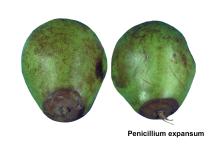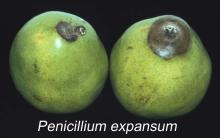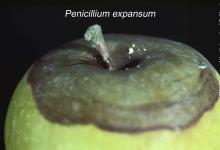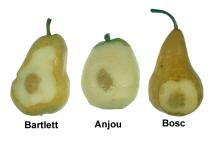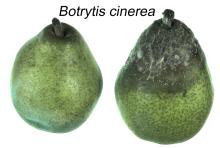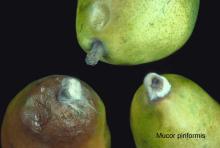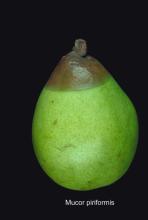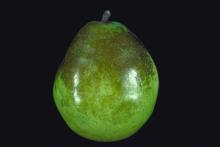Product Description
Indices de Maturité
Flesh firmness is used as a maturity index as follows:
| Flesh Firmness (Pounds-Force) | |||
| Cultivar | Maximum | Optimum | Minimum |
| Anjou | 15 | 13 | 10 |
| Bosc | 16 | 13 | 11 |
| Comice | 13 | 11 | 9 |
Other indices include corking of lenticels, pattern of starch content, and internal ethylene concentration.
- Appearance. Color, size, shape, freedom from internal breakdown, blackened, russeting (presence or absence), bruising, scars, sunburn, insect damage, and other defects
- Texture. Firmness of the flesh, presence of sclereid cells
- Flavor. Taste related to contents of sugars and organic acids; aroma which is dependent upon volatiles (production may be enhanced by ethylene treatment during ripening of pears)
Manipulation et stockage post-récolte
-1 to 0°C (30 to 32°F); freezing temperatures are -1.5 to -2°C (29 to 28°F)
| Temperature | 0°C (32°F) | 5°C (41°F) | 10°C (50°F) | 20°C (68°F) |
|---|---|---|---|---|
| ml CO2/kg·hr | 1-3 | 3-6 | 5-10 | 15-30 |
To calculate heat production, multiply ml CO2/kg·hr by 440 to get Btu/ton/day or by 122 to get kcal/metric ton/day.
Low end for 'Anjou' and high end for 'Bosc' and 'Comice' pears.
Treating pears with 100 ppm ethylene for 1 to 2 days can substitute for cold storage [4 to 8 weeks at -1 to 0°C (30 to 32°F)] in enhancing ripening. Optimum conditions for ripening are 15-22°C (59-72°F; the higher the temperature the faster the ripening) and 90-95% relative humidity; CO2 should be kept below 1%.
90-95%
| Temperature | 0°C (32°F) | 5°C (41°F) | 10°C (50°F) | 20°C (68°F) |
| µl/kg·hr | 2-5 | 5-15 | 10-25 | 40-80 |
Low end for 'Anjou' and high end for 'Bosc' and 'Comice' pears.
Optimum range: 1-2% O2 + 0-1% CO2
Winter pear varieties can be stored in CA at -1°C (30°F) for up to 4 months (Bosc & Comice) or 6 months (Anjou) while maintaining their capacity to ripen and attain good flavor and texture.
Oxygen levels below 1% and/or carbon dioxide above 1% for longer than two weeks can induce physiological disorders; severity increases with lower 02%, higher CO2%, higher temperatures, and longer storage time.
Désordres
Senescent scald. Dark-brown skin discoloration begins as small spots and develops into large areas of skin turning brown after long term storage; brown skin may slough off. Prompt cooling and maintenance of optimum fruit temperature minimize this disorder. Occurs when fruit become senescent.
Superficial scald. Diffuse brown skin discoloration occurs after several months of storage and during ripening after storage. Scald inhibitors, such as ethoxyquin (not available in Calif.), may be used on pears that are stored longer than 3 months. Controlled-atmosphere storage delays scald incidence and severity.
Freezing injury. Translucent, water-soaked appearance of tissue while frozen. Upon thawing tissue turns brown and soft. Severe freezing causes cavities in the cortex. Freezing temperatures depend upon soluble solids content of pears.
Bitter pit (Cork spot, Anjou pit). Brown, corky lesions appear in the flesh, mainly toward the calyx end. An uneven surface with darker colored depressions indicates pitted tissue. High rates of nitrogen application increase the incidence of bitter pit while calcium sprays before harvest decrease its occurrence.
Carbon dioxide injury. Browning of interior walls of carpels and adjacent core tissue; in severe cases cortex tissue turns light brown and cavities may develop in damaged tissue. Susceptibility of pears to CO2 injury increases with advanced maturity, delayed cooling, prolonged storage, and low O2 levels during storage.
Low oxygen injury. Core browning and accumulation of fermentation volatiles (ethanol, acetaldehyde, and ethyl acetate). More mature pears are more susceptible to low O2 injury.
Botrytis rot (grey mold), caused by Botrytis cinerea, is the most serious storage disease of pears. Blue mold, caused by Penicillium expansum, is the second most important one. Alternaria rot (Alternaria alternata) and cladosporium rot (Cladosporium herbarum) occur only on senescent fruit at the end of the storage period. Side Rot (Phialophora malorum) is a significant problem in the Northwest. Mucor rot (Mucor spp.) may also attack pears in storage. Anthracnose rots (Bull's-eye rot, Cryptosporiopsis curvispora); lenticel rot, (Phyctema vagabunda); and bitter rot, (Colletotrichum gloeosporioides) can be a problem only if preharvest control treatments are inadequate.
- Effective preharvest disease control procedures
- Careful handling during harvesting and postharvest preparation for market to minimize mechanical injuries
- Prompt cooling to 0°C (32°F)
- Maintenance of proper temperature [-1 to 0°C (30 to 32°F)] during storage and transport
- Use of postharvest chemical treatments (sodium orthophenyl phenate or chlorine added to the dump tank water; thiabendazole applied in a line spray after sorting)
- Use of CA storage
References
References from scientifically validated sources will be added in the future.



